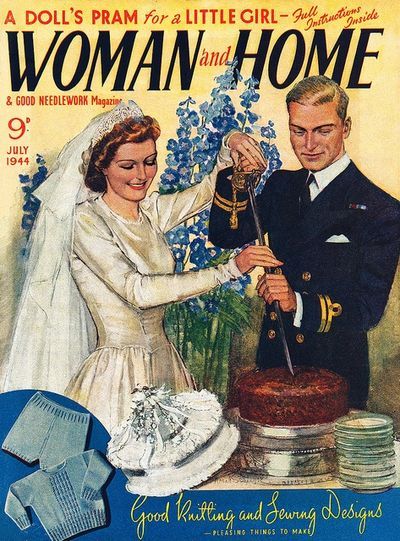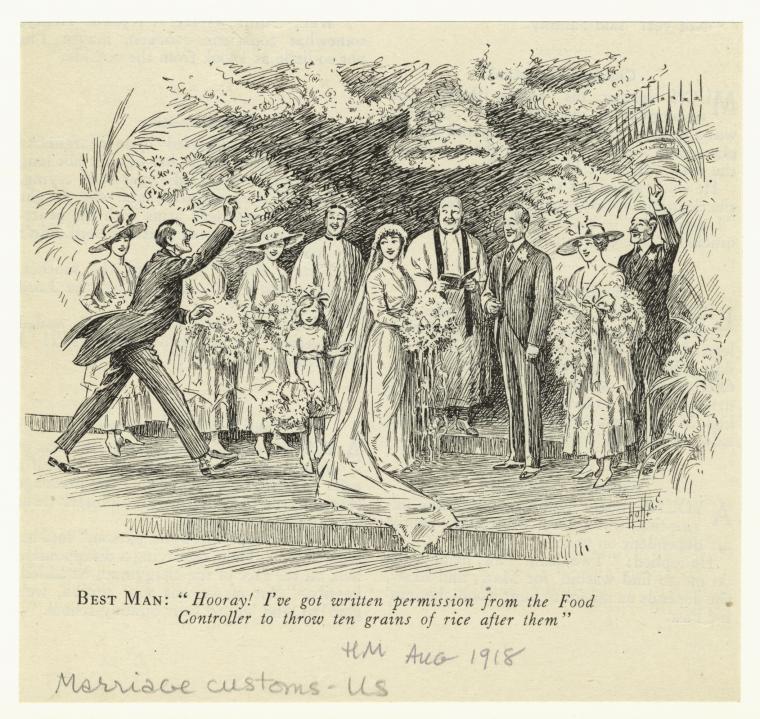|
Our 30th episode! Hard to believe we started in March, 2019 at episode 1! In this episode of Food History Happy Hour, we made the Pink Garter cocktail from 1946 and discussed all things wedding food! We started off with WWII rationing and wedding cakes, moved into 19th century wedding breakfasts, why they were called "breakfasts," and the types of food served, including the Medieval origins of wedding cakes, which were originally (and sometimes still are) fruitcake! Then we moved onto trends in cake design, the influence of Queen Victoria on fashionable weddings, and launched into a discussion of famous literary weddings (including Laura Ingalls Wilder and Meg March from Little Women) which then devolved into an (attempted) discussion of what was served at Miss Havisham's wedding breakfast.
In earnest pursuit of Anna Katherine's request to know what was at Miss Havisham's wedding breakfast, I could find no official reference. The original text only refers to the bride's cake and an epergne filled with something cobwebby and rotting. Almost certainly fruit if, like Elizabeth theorized, Miss Havisham's wedding had taken place in the 1810s.
I did, however, find an etiquette book from 1834 that had this to say about weddings: "The breakfast should be supplied by a first rate confectioner and the table should be as beautiful as flowers plate glass and china can make it. The ordinary menu of a wedding breakfast is as follows. Tea, coffee, wines, cold game and poultry, lobster salads, chicken and fish à la Mayonnaise, hams, tongues, potted meats, game pies, savory jellies, Italian creams, ices, and cold sweets of every description." So lots of meat, seafood, and sweets, all served cold. I can only imagine what rotting lobster or fish smelled like in Miss Havisham's house. Yuck. And while I wasn't able to find an actual menu from Queen Victoria and Prince Albert's wedding, I did find a clip from the show Anna Katherine was referring to! The Pink Garter (1946)
Tonight's cocktail came from perennial favorite The Roving Bartender by Bill Kelly, published in 1946. This was a very straightforward, very delicious drink. Super simple, but surprisingly complex-tasting. If you like raspberry lemonade, this drink will be right up your alley. If sweet drinks are not your thing, cut down on the grenadine, or up the gin ratio. It calls for:
1/3 ounce lemon juice 1/3 ounce grenadine 1 ounce dry gin Shake with ice and strain into a martini glass. I garnished mine with a maraschino cherry for extra pizazz. Still looking for more wedding food history? You can watch my illustrated talk as recorded recently for a library lecture!
That's all for this month's Food History Happy Hour! I've got a TON of talks coming up in June, so be sure to check out the events calendar, and we'll see you at the next Food History Happy Hour on June 18th!
The Food Historian blog is supported by patrons on Patreon! Patrons help keep blog posts like this one free and available to the public. Join us for awesome members-only content like free digitized cookbooks from my personal collection, e-newsletter, and even snail mail from time to time! Join by June 30, 2020 and get a picnic history packet mailed to your door!
Don't want to join Patreon? Use our new Tip Jar instead! You can make a one-time donation any time, not strings attached.
0 Comments
I ran across this little political cartoon when researching for my book Preserve or Perish, which is about food in New York during the First World War. I also study wedding food traditions, so of course when I saw this, I cracked up.
A wedding party is gathered at the altar, and everyone is turning to look at the best man, who is rushing up to the altar waving a piece of paper. The caption reads, "BEST MAN: 'Hooray! I've got written permission from the Food Controller to throw ten grains of rice after them.'" Although the New York Public Library doesn't list what newspaper or magazine it is from, it is dated as August, 1918. The cartoon is hilarious for a number of reasons, but the primary one is that it is a gross exaggeration of the level of food control in the United States during the First World War. With the exception of sugar toward the end of the war, mandatory rationing was never put into place for ordinary Americans. Only food producers and retailers had restrictions placed on them. On potential exemption from that (besides sugar) was the requirement that all customers had to buy two units of non-wheat grains or flours for every one unit of wheat they purchased. For example, by purchasing one pound white wheat flour, a shopper would be required to purchase an additional two pounds of some other grain (they could mix and match) such as cornmeal, rye flour, barley flour, rice, or oatmeal. Rice, however, was never rationed. In fact, although it was not as widely available as cornmeal, it was touted as a wheat substitute. But political cartoons are all about taking things to extremes, so the joke is that food is so heavily "controlled" that even a few grains of rice must have permission to be thrown away. Which also fits into the propaganda around wasting food that was prevalent at the time. The other interesting, although not particularly hilarious, commentary of this cartoon is that this is clearly a fairly wealthy family. Then men are wearing morning coats with tails and spats on their shoes. The bridesmaids are in matching outfits. The bride has a very long veil and there are flowers and greenery galore. It indicates that even the wealthiest Americans could not escape the reach of the "Food Controller" - a.k.a. Herbert Hoover, Federal Food Administrator (a term he vastly preferred to "controller" or even the popular-in-the-press "dictator," which did not have quite the same meaning then as it does now). The early 20th century was when marriage traditions were starting to solidify as weddings became more formal, public affairs. Throwing rice at the couple at the end of the wedding was one of those "traditions" at this point. Along with a white dress, flower bouquet, white bride's cake to eat at the breakfast (yeah, they were still breakfasts at this point, although luncheons and teas were becoming more common) and spice/fruitcake groom's cake to take some as a favor. In all, it's a cute-but-biting commentary on food control during the First World War. And it made me laugh, so I had to share. If you enjoyed this installment of #WorldWarWednesdays, consider becoming a Food Historian patron on Patreon! Members get to vote for new blog post and podcast topics, get access to my food library, research advice, and more! |
AuthorSarah Wassberg Johnson has an MA in Public History from the University at Albany and studies early 20th century food history. Archives
July 2024
Categories
All
|





 RSS Feed
RSS Feed